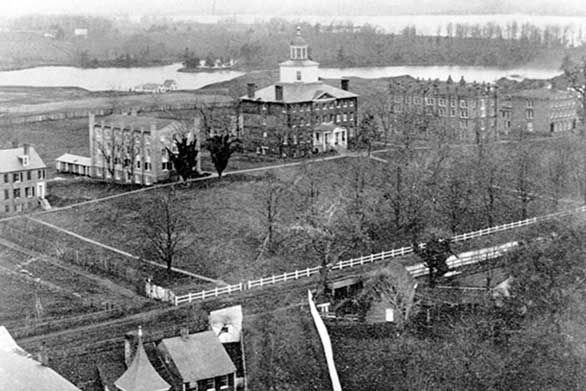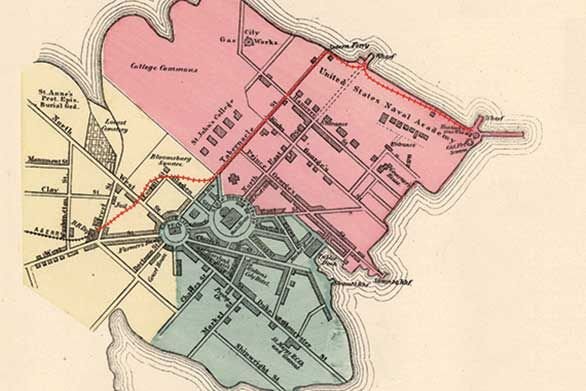Lincoln’s Walk
Spring 2017 | By Rebecca Wilson (H83) for The College

Members of the St. John’s community are aware that dedications have brought two American presidents to the Annapolis campus: William Howard Taft took part in the French Monument ceremony in 1911, while Dwight Eisenhower, after landing in a helicopter on back campus, charmed the faculty in 1958 when the Mellon-Key complex was dedicated.
Few are aware that several weeks before his assassination, Abraham Lincoln walked the width of the campus during a 45-minute visit to Annapolis. That occurred on February 2, 1865, when Lincoln was headed for the deep water wharf on the grounds of the Naval Academy. From there he sailed to what became known as the Hampton Roads Peace Conference in Virginia, leading to the end of the Civil War.
By then, St. John’s had been transformed into U.S. General Hospital Division 2. Tents for wounded and ill federal forces were pitched on back campus. At the Naval Academy, midshipmen and professors had been moved to Newport, Rhode Island, and that campus was serving as a large supply depot and hospital facility for Division 1.
Details of Lincoln’s visit, which also suggest what St. John’s College’s environment was like during those wartime years, are revealed in a history written by Rockford E. Toews and published by the Maryland State Archives: “Lincoln in Annapolis February 1865.”
Traveling by train from Washington, Lincoln arrived at 1 p.m. at the Annapolis & Elk Ridge Railroad, located at the corner of Calvert and West streets, from where Lincoln set off by foot for the Naval Academy wharf about half a mile away. Toews noted that the traffic was too heavy for him to go by carriage while the streets were unpaved and almost certainly muddy. He thinks that the most likely route Lincoln followed may have been along the route of the railroad extension laid out in 1861.
A map accompanying the article shows the route Lincoln is believed to have taken, based upon research by the Annapolis Lincoln Bicentennial Commission, the group that funded the booklet. Lincoln’s path is shown in a red line.

After leaving the rail station, it is thought that Lincoln walked over the Bloomsbury Square area on what was then known as Tabernacle Street—today’s College Avenue. He would have walked down Tabernacle, passing Prince George and King George streets on his right, and into the Naval Academy through a gate at the end of College Avenue. St. John’s would have been at his left. He would have seen the Paca-Carroll House, Humphreys Hall, McDowell Hall, Pinkney, Chase Stone, all built by 1865, and, of course, the then flourishing Liberty Tree.
Lincoln’s walk took him close to the State House, where the Maryland Senate was considering ratification of the Thirteenth Amendment, ending slavery. No account of his visit from the Annapolis paper survives, but a Baltimore American correspondent, who signed his name “Mac,” wrote:
“(H) Excellency, the President of the United States, arrived in Annapolis, entirely unannounced, and without any ostentatious ceremony whatever, but, like the Democratic Republican that he is, he quietly proceeded to the Naval Academy, where he embarked on the steamer Thomas Collyer and proceeded, I suppose, to City Point. He was accompanied only by a servant. So quiet and unobtrusive was his arrival and departure from the ancient city that scarcely a score knew of it until after the steamboat sailed. Had it become known that he was present in the Naval Academy’s Hospital, he would have had a gratifying and pleasing reception from the wounded and sick inmates of the institution. Many of the members of the Legislature expressed great regret at not having the pleasure of seeing the Chief Magistrate.”
News accounts differ on the number who accompanied Lincoln. “The Crutch,” published weekly by Hospital 1, reported:
“President Lincoln arrived here on Thursday by special train from Washington. No one was aware of this distinguished arrival until it was heralded by the Hospital Band, playing patriotic airs of welcome as he passed from the wharf to the boat.”
After boarding the Thomas Collyer, which Toews described as a “fast side-wheel” steamer, he departed from the mouth of the Severn River into the Chesapeake Bay, leaving Maryland for Virginia. The following day, on February 4, after an overnight trip, he steamed back to Annapolis to catch a 7:30 a.m. train. Back in Washington two hours later, Lincoln was never able to return to Annapolis.

